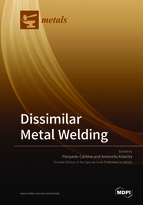Dissimilar Metal Welding
A special issue of Metals (ISSN 2075-4701). This special issue belongs to the section "Metal Casting, Forming and Heat Treatment".
Deadline for manuscript submissions: closed (20 February 2019) | Viewed by 86806
Special Issue Editors
Interests: friction stir welding; surface modification technologies; cold spray process
Special Issues, Collections and Topics in MDPI journals
Interests: manufacturing; additive manufacturing; solid state processes; microstructure; cold spray
Special Issues, Collections and Topics in MDPI journals
Special Issue Information
Dear Colleagues,
The combination of distinct materials is a key issue in modern industry, whereas the driving concept is to design parts with the right material in the right place. In this framework, a great deal of attention is directed towards dissimilar welding and joining technologies. In the automotive sector, for instance, the concept of “tailored blanks”, introduced in the last decade, has further highlighted the necessity to weld dissimilar materials. As far as the aeronautic field is concerned, most structures are built combining very different materials and alloys, in order to match lightweight and structural performance requirements.
In this framework, the application of fusion welding techniques, namely tungsten inert gas or laser welding, is quite challenging due to the difference in physical properties, in particular the melting point, between adjoining materials. On the other hand, solid state welding methods, such as the friction stir welding as well as linear friction welding processes process, already proved to be capable of manufacturing sound Al-Cu, Al-Ti, Al-SS, Al-Mg joints, to cite but a few. Recently, promising results have also been obtained using hybrid methods.
Considering the novelty of the topic, different relevant issues are still open and many research groups are continuously publishing valuable results concerning:
- Welding process development (tooling and fixtures design, force analysis, temperature analysis, hybrid welding, process monitoring and control);
- Metallurgical aspects (microstructure evolution and precipitation of intermetallic compounds);
- Electrochemical studies (galvanic corrosion);
- Mechanical characterization and fracture analysis;
- Numerical modelling of the process and of the joint behavior.
The aim of this Special Issue is to wrap up the latest studies on these topics.
Prof. Dr. Pierpaolo Carlone
Dr. Antonello Astarita
Guest Editors
Manuscript Submission Information
Manuscripts should be submitted online at www.mdpi.com by registering and logging in to this website. Once you are registered, click here to go to the submission form. Manuscripts can be submitted until the deadline. All submissions that pass pre-check are peer-reviewed. Accepted papers will be published continuously in the journal (as soon as accepted) and will be listed together on the special issue website. Research articles, review articles as well as short communications are invited. For planned papers, a title and short abstract (about 100 words) can be sent to the Editorial Office for announcement on this website.
Submitted manuscripts should not have been published previously, nor be under consideration for publication elsewhere (except conference proceedings papers). All manuscripts are thoroughly refereed through a single-blind peer-review process. A guide for authors and other relevant information for submission of manuscripts is available on the Instructions for Authors page. Metals is an international peer-reviewed open access monthly journal published by MDPI.
Please visit the Instructions for Authors page before submitting a manuscript. The Article Processing Charge (APC) for publication in this open access journal is 2600 CHF (Swiss Francs). Submitted papers should be well formatted and use good English. Authors may use MDPI's English editing service prior to publication or during author revisions.







